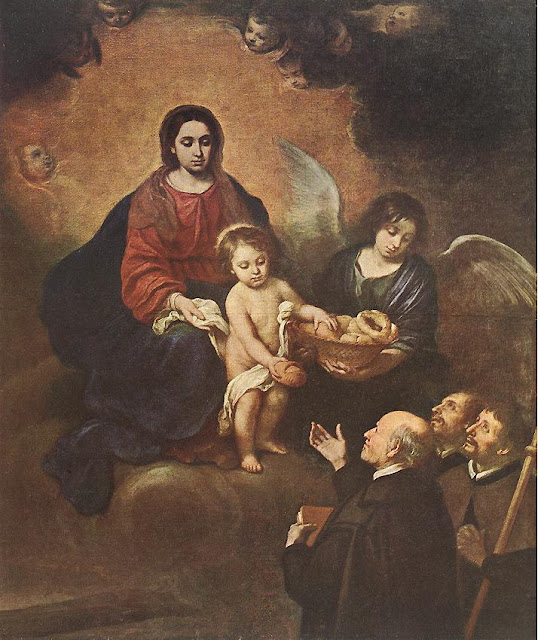Bartolomé Esteban Murillo
From Wikipedia, the free encyclopedia
| Bartolomé Esteban Murillo | |
|---|---|
| Born | late December 1617; baptised January 1, 1618 Seville, Spain |
| Died | April 3, 1682 (aged 64) Seville, Spain |
| Nationality | Spanish |
| Field | Painting, Drawing |
| Movement | Baroque |
Contents |
Life
Murillo was born to Gaspar Estaban Murillo and Maria Perez. He may have been born in Seville or in Pilas, a smaller Andalusian town.[1] It is clear that he was baptized in Seville in 1618, the youngest son in a family of fourteen. His father was a barber and surgeon. His parents died when Murillo was still very young, and the artist was largely brought up by his aunt and uncle. Murillo married Beatriz Cabrera in 1645; their first child, named Maria, was born shortly after their marriage. The mother and daughter became the subjects of two of his paintings: The Virgin of the Rosary[2] and Madonna and Child.Career
Murillo began his art studies under Juan del Castillo in Seville. Murillo became familiar with Flemish painting; the great commercial importance of Seville at the time ensured that he was also subject to influences from other regions. His first works were influenced by Zurbarán, Jusepe de Ribera and Alonzo Cano, and he shared their strongly realist approach. As his painting developed, his more important works evolved towards the polished style that suited the bourgeois and aristocratic tastes of the time, demonstrated especially in his Roman Catholic religious works.In 1642, at the age of 26, he moved to Madrid, where he most likely became familiar with the work of Velázquez, and would have seen the work of Venetian and Flemish masters in the royal collections; the rich colors and softly modeled forms of his subsequent work suggest these influences.[2] He returned to Seville in 1645. In that year, he painted thirteen canvases for the monastery of St. Francisco el Grande in Seville which improved his reputation. Following the completion of a pair of pictures for the Seville Cathedral, he began to specialize in the themes that brought him his greatest successes: the Virgin and Child and the Immaculate Conception.[3]
After another period in Madrid, from 1658 to 1660, he returned to Seville. Here he was one of the founders of the Academia de Bellas Artes (Academy of Art), sharing its direction, in 1660, with the architect Francisco Herrera the Younger. This was his period of greatest activity, and he received numerous important commissions, among them the altarpieces for the Augustinian monastery, the paintings for Santa María la Blanca (completed in 1665), and others. He died in Seville in 1682 at the age of 64.
Legacy
Murillo room in Museum of Cádiz
Works on Display in the United States
His painting Christ on the Cross is at the Timken Museum of Art in San Diego.[4] Two of his paintings are entitled Christ After the Flagellation, and one of these is at the Krannert Art Museum, Champaign, IL.[5] His work is also found at the Mabee-Gerrer Museum of Art in Shawnee, OK.Gallery
-
Beggar Boys Eating Grapes and Melon, Alte Pinakothek
-
St. Isidore of Seville, Cathedral of Seville
-
St. Leander of Seville, Cathedral of Seville
-
St. Francis Solanus, Alcazar, Seville
-
Murillo's La Inmaculada Concepción del espejo, Museo de Arte de Ponce
Notes
- ^ O'Neill 1833, p. 246.
- ^ a b c "Bartolome Esteban Murillo". Encyclopædia Britannica, Inc.. Retrieved 2007-08-30.
- ^ The center medallion of the badge of the Spanish Order of Charles III is clearly modeled on Murillo's unique manner of representing the Immaculate Conception.
- ^ "Christ on the Cross". Timken Museum of Art.
- ^ "Christ After the Flagellation". Krannert Art Museum.






.jpg)














.jpg)










.jpg)


.jpg)

.jpg)

.jpg)
.jpg)
Post a Comment